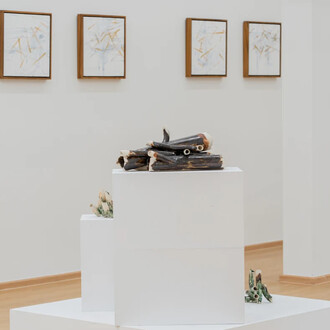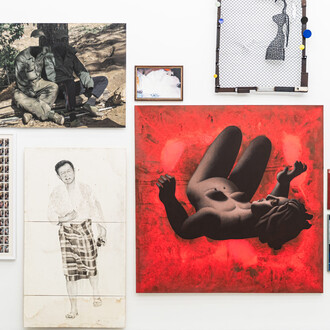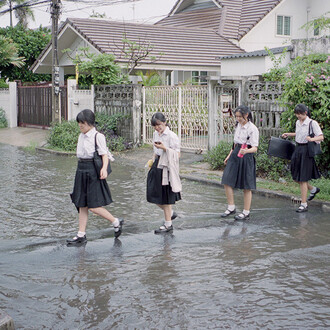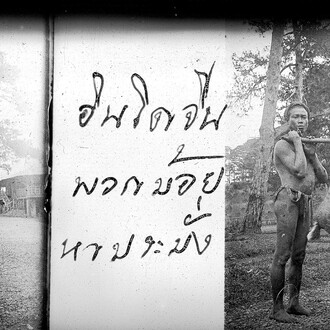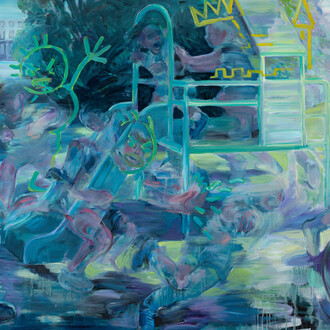If only it is seen, thus, from afar is a poignant elegy and a radical exploration—the first queer Myanmar exhibition of emerging artists. Curated by Sid Kaung Sett Lin and Bodhisattva LGBTQ+ Gallery, it gathers eight Myanmar artists—Zicky Le, Sin Hu, Swannie, Roxy Owan, Na Torah, Min Chit Paing, Htet Aung Lwyn, and Kyaw Min Htet currently based in Bangkok and Chiang Mai, this exhibition captures the tender, turbulent emotional currents of those who have left their homeland—whether lured by love, driven by work, or compelled by survival—and the complex interplay of belonging and alienation in a foreign city like the neighbouring Bangkok.
Set in a city both mirror and stranger to their hometown, their art pulses with the quiet ache of souls caught between home and horizon, expressed through time-based media, moving images, photography, sculpture, and performance. Most of these artists are new to the contemporary art world, their voices fresh yet resonant, though many have already achieved success in fashion editorials and campaigns, marking their emergence here as instinctive rather than professional.
The title, a whispered refrain, a soft echo of longing, calls for a gaze that lingers between intimacy and distance, echoing Yukio Mishima’s Sun and Steel, where a warrior-phoenix carves eternity from frailty, and NewJeans’ Cool With You, where Eros blooms fleetingly in love’s deluge. These artifacts, one a literary evidence to art and ritual death, the other a contemporary K-pop diptych of mythic allure, entwine to frame the artists’ meditations on permanence and transience, solitude and connection, grounding their queer Myanmar narratives.
Free from traditional constraints, the exhibition embraces fluid mediums, entwined with sentimental resonance shared among all the artists. Na Torah’s This life was given to me, a sculptural and video work, enacts a ritual of self-birth. A genderless torso and mask-like sculpture embody balance and soul, with performative bodypainting and mask removal symbolizing transformation. Her obsession on combining organic sounds resonates as a haunting call in a visceral video of renewal, binding the exhibition’s emotional core.
Whereas, Zicky Le’s photography series layers a contemporary belonging and with a diasporic reimagining of home, turning departure into dialogue– tracing a sensibility in formation—intimate, atmospheric, and quietly persistent. Along with that, Sin Hu’s sewed latex-skin sculptures explore relationships that shape his identity, balancing feminine and masculine energies through connections with parents, partners, and family.
Swannie’s A body on repeat, a performance video, reclaims Burmese traditional dance to explore trans identity’s cyclical struggles, rejecting the pressure to perform for binary societal standards. Rooted in Swannie’s childhood experience of Burmese traditional dance—where movement was a fleeting refuge met with humiliation—this work reclaims those early steps. Through choreographed sequences that recall memory and defiance, Swannie’s performance embodies the tension between self and expectation, celebrating the messy, ever-evolving process of becoming.
Min Chit Paing’s text-based installation invites interaction with stories from his 2021–2025 journeys, shaped by displacement from Myanmar’s political crisis and his 2024 arrival in Thailand. His subtle, soft yet quietly powerful pieces, documenting a journey while amplifying underrepresented queer literature in his region. Based in between Chiang Mai and Bangkok during the same period, Kyaw Min Htet’s mantra-like installation performs a bold narrative, seeking temporary warmth, intimacy and longing in diaspora. Roxy Owan’s photographs from her ongoing Petal of Being series capture a profound transformation, forging a new identity as she navigates her new environment with both triumphs and challenges.
Lastly, Htet Aung Lwyn’s Super 8mm demon confronts his personal trauma, reflecting the psychological toll of navigating a mainstream world full of demands. Through a raw, honest depiction of suffering and reflection, the work explores how repetition becomes performative, a process of revisiting and revising past pain. By unleashing the "demon" of these unresolved experiences, the piece questions whether art itself becomes an act of giving—an offering of vulnerability and catharsis.
Bangkok, a crossroads of choice and fate, amplifies their ephemeral home, posing questions: Can friendships forge a sense of belonging? Can identity anchor a shifting self? Each work, from swept crumbs to unlocked doors, is a fragment of rebirth, a hymn to survival. As many Myanmar artists find themselves in Bangkok—a city at once a mirror and a stranger to their native Yangon—the exhibition captures the duality of familiarity and distance. If only it is seen, thus, from afar invites you to pause in this reverie, where kindred spirits cradle a wounded home, and the soul’s fragile dance unfolds, seen, thus, from afar.





